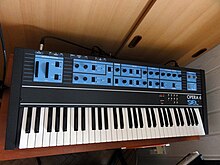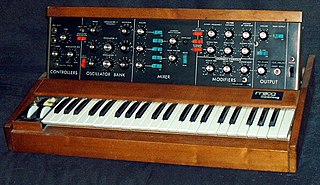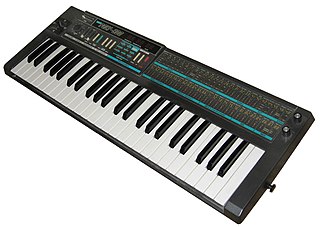 | |
| SIEL | |
| Headquarters | Italy |
Societa Industrie Elettroniche (SIEL) was an Italian company that made electronic organs and synthesizers in the 1980s.
 | |
| SIEL | |
| Headquarters | Italy |
Societa Industrie Elettroniche (SIEL) was an Italian company that made electronic organs and synthesizers in the 1980s.


An analog synthesizer is a synthesizer that uses analog circuits and analog signals to generate sound electronically.
A digitally controlled oscillator or DCO is used in synthesizers, microcontrollers, and software-defined radios. The name is analogous with "voltage-controlled oscillator". DCOs were designed to overcome the tuning stability limitations of early VCO designs.

Oberheim is an American synthesizer manufacturer founded in 1969 by Tom Oberheim. Beginning in 1975, Oberheim developed some of the first commmercially-available polyphonic synthesizers and was a prominent synthesizer and drum machine manufacturer through the mid-1980s. In 1988, the company changed ownership and was eventually purchased by Gibson Guitar Corporation, which developed new Oberheim products and licensed the trademark to other companies that produced Oberheim products, but development of Oberheim products ceased after 2000. In 2009, Tom Oberheim began developing instruments through his own company, and in 2019, Gibson returned the Oberheim trademark to Tom Oberheim, whose company rebranded as Oberheim.

The Korg Poly-800 is an 8-voice analog synthesizer released by Korg in 1983. Its initial list price of $795 made it the first fully programmable polyphonic synthesizer that sold for less than $1,000. It was designed for portability, featuring battery power and a lightweight design that allowed the user to play with it strapped around their neck. It utilized digitally controlled oscillators (DCOs), and was a paraphonic synth with a single filter shared between its eight voices.
Doepfer Musikelektronik GmbH is a German manufacturer of audio hardware, mostly modular synthesizers, based in Gräfelfing, Upper Bavaria, Germany and founded by Dieter Döpfer. The product range covers analog modular systems, MIDI controllers, MIDI hardware sequencers, MIDI-to-CV/Gate/Sync Interfaces, MIDI master keyboards and special MIDI equipment.

Crumar is an Italian manufacturer of electronic musical instruments. It was established by Mario Crucianelli in the late 1960s, and manufactured synthesizers and keyboards during the '70s and '80s. Its name is a portmanteau of "Crucianelli" and the name of his business partner, Marchetti. The company appears to have grown out of the Crucianelli accordion company and also continued to manufacture accordions under both names.
The Memorymoog is a polyphonic electronic music synthesizer manufactured by Moog Music from 1982 to 1985, the last polyphonic synthesizer to be released by Moog Music before the company declared bankruptcy in 1987. While comparable to other polyphonic synthesizers of the time period, such as the Sequential Circuits Prophet-5 and Oberheim OB-Xa, the Memorymoog distinguished itself with an additional, 3rd audio oscillator per voice and greater preset storage capacity.

Palm Products GmbH was a manufacturer of audio synthesizers. Founded and owned by Wolfgang Palm, PPG was located in Hamburg, Germany and, for 12 years from around 1975 to 1987, manufactured an acclaimed and eclectic range of electronic musical instruments, all designed by Palm.
Polyphony is a property of musical instruments that means that they can play multiple independent melody lines simultaneously. Instruments featuring polyphony are said to be polyphonic. Instruments that are not capable of polyphony are monophonic or paraphonic.
The Korg Poly-61(PS-61) is an analog synthesizer manufactured by Korg between 1982 and 1986. It was the first affordable synthesizer to feature two oscillators per voice, and was Korg's first synthesizer to feature digitally-controlled analog oscillators (DCOs). The Poly-61 marked a significant departure in design philosophy from previous Korg synthesizers by replacing the traditional array of dedicated control knobs on the front panel with a digital interface that required users to select parameters individually for adjustment.
The Siel DK70 is a synthesizer produced in 1986 by Siel.
Viscount International SpA (Viscount) is a musical instrument manufacturer based in Mondaino, Italy. The brand Viscount was registered in 1969 by Marcello Galanti, but the company was established in the late 19th century by his forefather Antonio Galanti. After 1969 Viscount's primary focus has been on classic organs and digital pianos. Several alternative brands were formed in the 2000s to aim at expanding into other markets: VERSE and Voice Systems, respectively, for the high and low-end Pro-Audio markets and Physis for digital organs using Viscount's physical modeling technology. The company also used the Oberheim brand for several years, to market vintage organs, synthesizers and guitar effects. Currently, Viscount's manufacturing and R&D activity is based in Italy. The company has been continuously owned by the Galanti family since its inception.
Casio's SDSynthesizers were a late-1980s line of analog synthesizers featuring a resonant filter. SD synthesis was traditional DCO-analog synthesis, with the main difference being that some of the SD waveforms' harmonic spectrums changed temporally, or dynamically in relation to the amplitude envelope.

The Roland System-100M was a modular analog synthesizer manufactured by the Roland Corporation in the late 1970s and early 1980s. It was the successor of the Roland System-100, a semi-modular keyboard.

The Prophet '08 is a polyphonic analog synthesizer released by Dave Smith Instruments (DSI) in 2007. As with DSI's other instruments, the Prophet '08 uses analog subtractive synthesis. Similar in functionality to the renowned Sequential Circuits Prophet-5 popularized in the 1970s, the Prophet '08 has an all analog signal path; however its envelopes are generated digitally.

The AX80 is a polyphonic analogue keyboard synthesizer manufactured by Akai Professional in 1984. It was Akai's first venture into the professional electronic musical instrument market. The AX80 used digitally controlled oscillators (DCO) and filter circuitry based on the Curtis Electromusic CEM 3372 integrated circuit. It was marketed as part of a line of project studio equipment called the Akai Music Studio System, which included the S612 digital sampler the MR16 drum machine, the MS08 sequencer, and the MG1212 multitrack tape recorder.

The Siel Orchestra is an analogue subtractive synthesizer, which was produced by Italian manufacturer Siel from 1979 to 1982. The original Orchestra was very limited but still a very characteristic instrument for its time. It produces its sounds from a divide-down oscillator network and therefore has 49-note (unlimited) polyphony. Although it contains 4 sections of presets, which each contain two sounds, the only parameters that can be edited are Vibrato (LFO), Brilliance, Attack and Decay. This ultimately means that the Orchestra cannot produce many different sounds; however because of its Italian origin and its distinctive routing, the Orchestra sound is not matched by any other similar synthesizers.
The Roland MKS-80 Super Jupiter is a rack mount sound module version of the Roland Jupiter-6 and the Roland Jupiter-8 synthesizers. It is an 8-voice polyphonic analog synthesizer that was manufactured by Roland between 1984 and 1987. It is the only one of the MKS series of synthesizers to have analogue voltage-controlled oscillators (VCOs) instead of analogue digitally-controlled oscillators (DCOs). The voice architecture is almost identical to the Jupiter-6 synthesizer. The service manual states that "The module board of MKS-80 features the following in addition to that of JP-6, its brother module. 1) HPF. 2) Low boost circuit in the 2nd VCA. 3) DC supply current boost circuit (IC50)."
The Roland GR-300 is an analog guitar synthesizer manufactured by Roland Corporation. It was introduced to market in 1980.
The history of keyboard instruments lies in mechanical musical instrument keyboards, electrified keyboards and 1960s and 1970s synthesizer technologies.